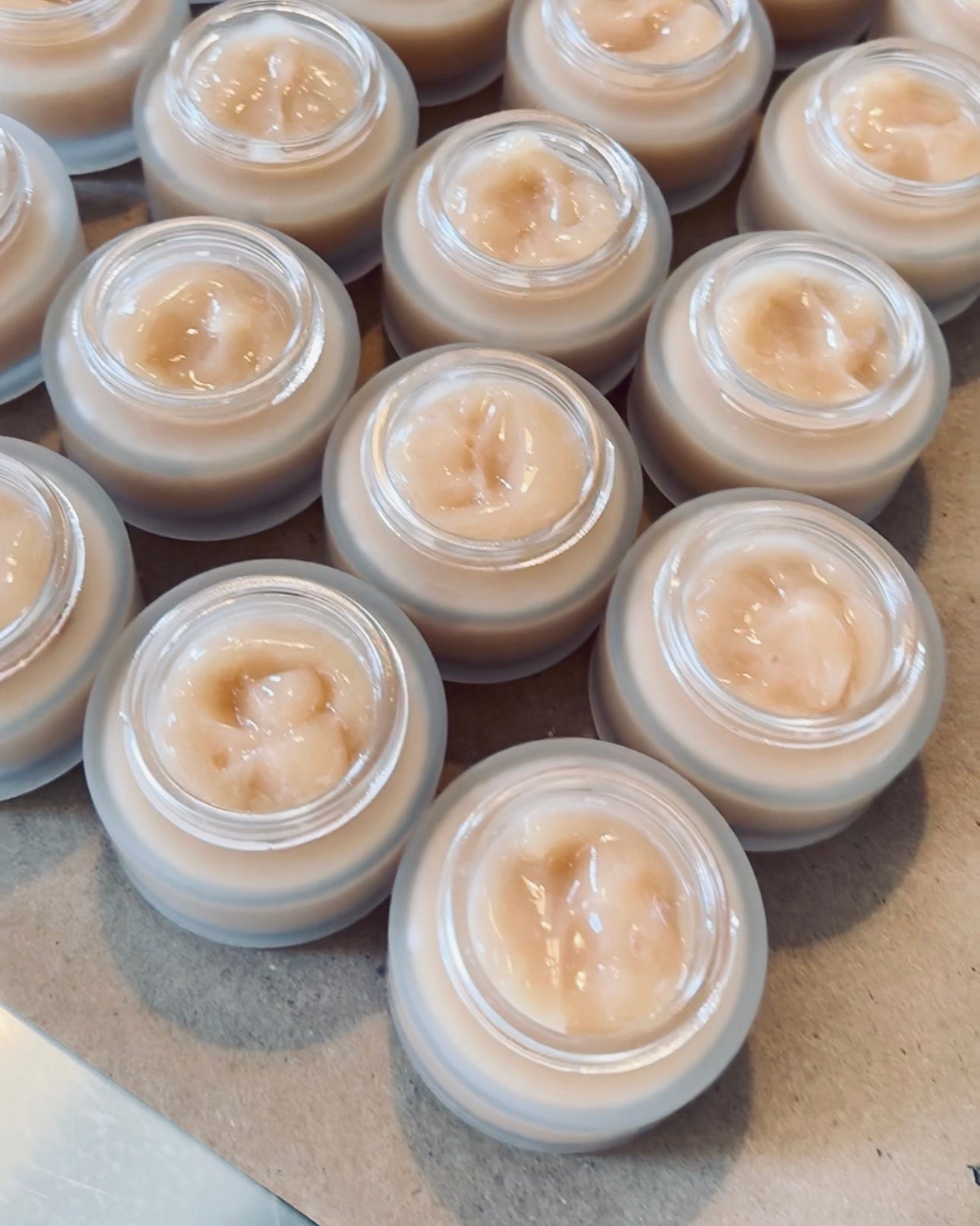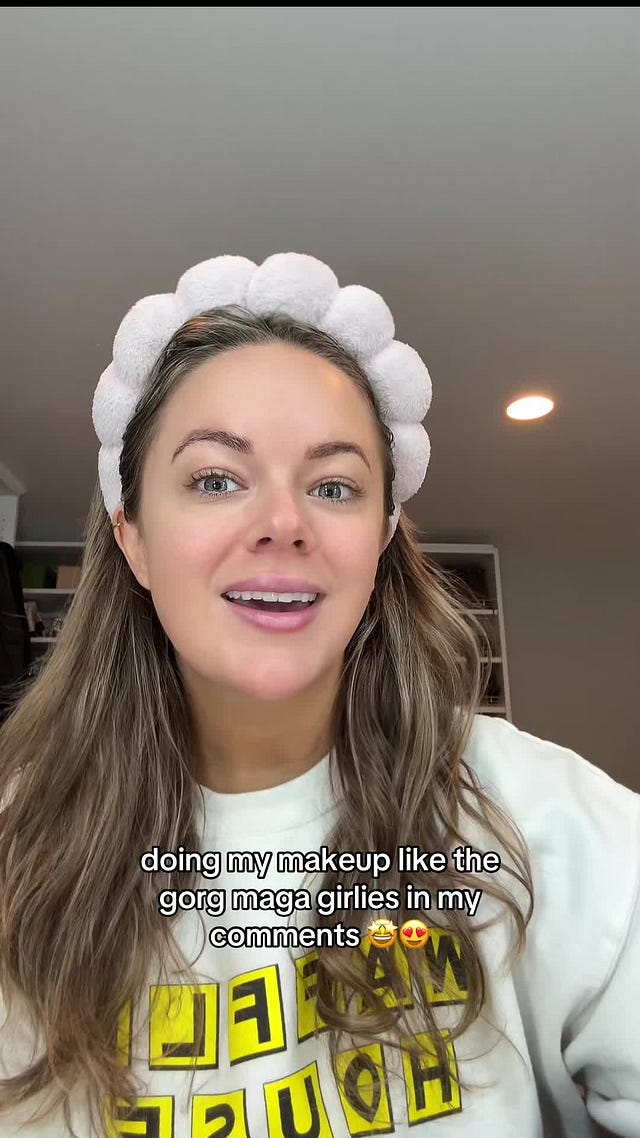Hello, I’m Adeline. I write Ginseng & Tonic to deliver a straight shot of cultural & skincare analysis to your inbox every most Sundays. Subscribe for deep dives into the intersections of culture and beauty by a former cultural studies professor and current skincare formulator and beauty brand owner.
I stare at the orderly, pleasing arrangement of jars of moisturizer around me that have been freshly piped into each container. Their perfect peaks are delectable, seemingly inviting a finger to sensuously dip into each jar’s hydrating goop. Gazing on their neat and tidy arrangement into straight rows invites my mind to declutter itself and sink into a sense of peace.
My mind, however, is having no such thing. It’s terrified that the right wing has so deeply infiltrated culture that increasing numbers of young women are declaring birth control “propaganda.” It’s slack jawed that MAHA-adjacent indie beauty brands are spreading the lie that sunscreen is “toxic.” It’s careening off wondering if my little brand is going to survive the on-again, off-again tariffs despite being a made-in-USA business. It’s stricken with anxiety wondering if it is ever safe to take off on an airplane on American soil again.
The world is burning. And as I freak out I wonder whether my work is pointless. Why dwell on making skin beautiful amid a country in flames? The perfectly piped moisturizer I’m staring at seems to do absolutely nothing to make the world around me better.
So I’ve been pondering on this question since January 20th. And answering it made me bring together three completely disparate phenomena: beauty parlors in Ukraine, the Republican Makeup social media trend and the history of cornrows. These three utterly distinct things bring together the relevance of beauty while the world is burning: because beauty can help us reclaim normalcy in trauma; to critique oppression and to communicate resistance.
Beauty is, has been, and can be a vehicle for more than wanton capitalist consumption to lull you into forgetting the horrors you’re surrounded by. So if you’ve been staring at your burgeoning collection of cherry hued lip stains wanting to find more meaning to your beauty practices, you’ll want to keep reading.
Beauty Parlors In Ukraine, Grooming through Depression & the Healing Power of Beauty
In February 2025, Allure ran a feature on beauty parlor owners in Ukraine, interviewing them on their choices to continue operations despite of the turmoil of the war. Initially, one interviewee said that when the war began, she thought that she would never work again. What’s the point of giving manicures and dye jobs when rockets are flying over your head?

Yet after a few months, many owners started reopening their salons. Some said it was because they felt a responsibility to support their staff and contribute to the economy. But what was most striking was the sheer demand they experienced upon reopening: Ukrainian women were craving returning to the salon. For these women, these salon visits played a huge role in helping them to feel human again. Being able to take part in beauty rituals helped them feel some sense of control.
Even outside of active conflict zones, beauty rituals possess healing powers. When a friend is deeply depressed, a standard action item given to help is to get them to take a shower and change into fresh clothes. Even though these are just basic acts of grooming, the effect is transformative.
Visiting a beauty salon in wartime, performing simple acts of grooming to pull oneself out of depression: both signal the ways that beauty is a vehicle for holding ourselves together when our identities feel otherwise shattered.
Republican Makeup & Satire
In January you may have seen the hilarious “Republican Makeup” trend hit your For You page. Started by comedian Suzanne Lambert, this trend lambasts “MAGA makeup” by making fun of the dry, patchy skin, mismatched foundation and clumpy mascara of some of the most prominent female Republican politicians.
Lambert’s starts her satirical video saying: “I noticed that all of the Republican girlies in my comments do their makeup the exact same, gorgeous way, so I thought that I would try to do it myself,” while putting on foundation that clashes with her undertones, applying it so it streaks and reveals a different skin tone underneath, and unmoisturized, “it’s giving dusty” skin. Her video now has over 6.4 million views.
 Tiktok failed to load.
Tiktok failed to load.Enable 3rd party cookies or use another browser
The Republican Makeup is an example of beauty as satire: beauty used as a vehicle to searingly critique conservatism. So much of what Lambert points out—streaky, mismatched foundation looking like badly-applied self-tanner, heavy brow makeup that aspires to look like a beauty filter in real life but gone wrong — calls into sharp relief the artifice and inauthenticity of the right wing, both in terms of appearance and values.
While most reactions to Republican Makeup has been untrammeled delight (or livid rage), some commentators have also argued that implicit in this is a moralization of beauty standards that women must adhere to; and that this critique is simply superficial because it doesn’t include any explicit call to political action.
But these critiques miss the power of beauty as vehicle for satire, and the importance of satire as political commentary and critique. The Republican Makeup trend would not have hit this hard of a nerve if conservative beauty norms were not already on the ascendant. In January 2025, The Times published a piece that declared “Republican Style Is Back.” Tradwives and hyper-traditional forms of femininity have been trending on social media, as is their symbol, the milkmaid dress. Even Substacker
wonders to herself whether she is romanticizing Republicanism as she adds conservative aesthetic clothes to her cart.Satire on the level of beauty hits a nerve the way criticizing policy does not. Critiquing appearance makes everyone feel in a way that listing egregious actions does not. Beauty satire is one of the most forceful forms of political satire and should not be dismissed.
Braids, Cornrows & Beauty as Resistance
Historically, beauty has also been used as a vehicle for resistance, often as code to enable communication when direct speech is dangerous. During the Underground Railroad, African-American women used braids and other traditional hairstyles to communicate escape routes, hide maps and carry supplies to help each other escape towards freedom. Cornrows were also used to encrypt messages and maps to aid escape into remote areas in Colombia.
Correspondingly, in post-Roe Texas, women have been alluding to beauty and self-care rituals in order to communicate indirectly about ways to obtain reproductive care. Using emojis, euphemisms and recipes to indirectly speak about reproductive health, Texan women share Instagram stories with titles like “Self Care Sunday” which often carry maps to resources, travel advice or underground networks of care.
Here, beauty is a vehicle for coded communication. Appearing frivolous is integral to serving as a cover for community resistance and underground networks of care. The more beauty is dismissed, the more effective it becomes.
Self Care: Reframing Commodification & Frivolity
Does all of this mean that there is deeper meaning to your overflowing collection of eyeshadow palettes and multi-step skincare routines?
Not necessarily. While self-care enthusiasts often pull out the Audre Lorde quote “Caring for myself is not self-indulgence, it is self-preservation, and that is an act of political warfare” to justify their indulgences, there has been valid criticism of how this quote has been appropriated.
argues: “Self-care isn’t an act of political warfare when you’re not engaged in any other act of political warfare, and are in fact ensconced from political warfare altogether.”I’ve tried to show in this piece that beauty practices are not intrinsically loaded with value one way or another. Beauty can be self-preservation and political warfare. And it can also be a vehicle for self-commodification and emotional numbing. Beauty can be both at the same time.
Beauty is a vehicle. It can oppress; it can liberate. Beauty can be used to uphold oppressive standards; it can also be used for effective satirical critique.
Assuming that beauty is irrelevant when the world is burning is a mistake. Beauty is a vehicle that can be used for many purposes. Its power comes from how intimate appearance is to each of us and how it gives us our sense of self. This deep intimacy conjures up strong emotions within which lie its power and potential.
Beauty is also inherently political. We are seeing this most clearly in this current moment with the impact of MAHA and indie beauty brands spreading the lie that sunscreen is “toxic.”
When I hold this in mind when I return to looking at my orderly rows of jars of moisturizer, each jar containing a perfectly piped peak, this helps me to find more meaning in my everyday work. Beauty is far from irrelevant; it’s connected to how we find our sense of self but also our safety, our sense of community and our agency. We all have a choice about how we want to drive this vehicle.
Found this piece interesting? Read more of my work:
Conservative Beauty Trends: Tradwives, Hyperfemininity & the New Face of MAGA
How to Not Panic: From Someone Who Is Always Panicking
The Outrage is the Point: Hate & Arousal in Politics, Marketing & Beauty







